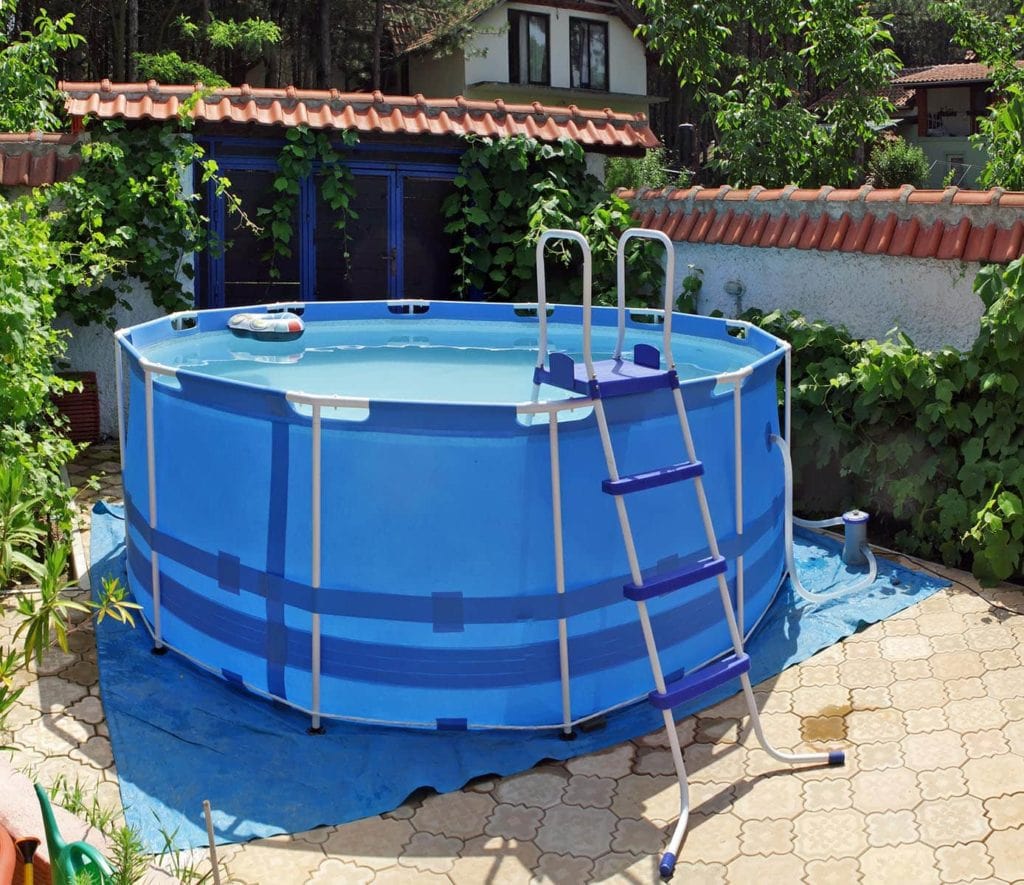How to Lower the Alkalinity in Your Above Ground Pool
-

- Last updated:


If you have discovered that your pool’s alkalinity is too high, you may be wondering how you can bring it down. You may also be concerned about what might happen from having pool alkalinity that is too high and if there are any safety risks.
Keep reading while we get to the bottom of these questions and also discuss the steps required to lower your pool’s alkalinity.
High Alkalinity Side Effects
High alkalinity can throw off your pH and can lead to cloudy water due to too much calcium in the water. In extreme cases, it can lead to mineral deposits, called scaling, to occur in your pipes. This condition can also cause the pressure in your pump to increase, and it can even block your filter.
The most common side effect of alkalinity that’s too high is itchy skin and burning eyes, and it’s not too hard to get it under control.
Testing the Water
It’s not hard to check the alkalinity of the pool water and only requires using a test strip. Test strips are easy to obtain, and most brands will give you both the alkalinity and pH level of your pool. Once you check the alkalinity, if It reads high, you will need to bring it down.
- AFFORDABLE 7-IN-1 POOL TESTING KIT: Our 100 pool test strips provides an affordable, all in one pool water testing kit for various...
- QUICK & EASY: Simplify your pool and spa testing with our easy pool testing strips. Just dip our hot tub test strips into the water for...
- ACCURATE & RELIABLE: Our swimming pool test strips deliver highly precise readings, ensuring the safety and cleanliness of your pool or...
Make sure to check your alkalinity often because it can change quickly due to rainfall and refilling your pool. It can also vary due to sunscreen and other lotions in the water.
The 2 Ways to Reduce the Alkalinity
To reduce the alkalinity of your pool, you can use either sodium bisulfate or muriatic acid. Before you use either of these chemicals, stop the pump, and let your pool settle down for several hours. Allowing the currents in the water to stop will help prevent the acid from affecting the pH of your pool.
1. Sodium Bisulfate
You usually purchase sodium bisulfate in a powder form, and of the two chemicals, this is slower acting.
Before using this chemical check, the packaging to get an idea of how much you should use. We recommend starting with half the recommended amount.
- We recommend mixing a small amount into a pail of water and making sure it’s completely dissolved before slowly dumping into your pool in a steady, deliberate stream. You want the solution to dive down deep and not create a lot of splashing, or you risk affecting the pH of your pool.
- Allow the pool to set for a few hours to allow the solution to disperse naturally before turning the pump on and allowing it to run for several hours.
- Use a test trip to recheck the alkalinity the following day. If it still requires sodium bisulfate, Create another batch of the solution.
No products found.
Muriatic Acid
Muriatic acid is a liquid, and it’s quite a bit stronger than sodium bisulfate. Extra care will be required if you choose to go with this chemical. However, it is much more effective, and you’ll need a smaller amount. The restrictions for using muriatic acid are practically the same as those for sodium bisulfate.
- First, read the label to get an idea of how much muriatic acid you are going to need, and we recommend starting with about half that amount.
- Many people like to dilute the muriatic acid with water before dumping it into the pool, but we prefer to pour the acid straight into the pool. Pouring the muriatic acid straight into the pool means less handling of the acid. The choice is yours, and there’s no wrong way.
- As we did with sodium bisulfate, let the acid sit after you pour it in for a few hours To allow it to disperse naturally and reduce its effects on your pool’s pH. Once a few hours have passed, turn your pump on and allow it to run a full cycle.
- Recheck the water the next day with a test strip, and if it still requires more muriatic acid, create another small batch and repeat these steps.
- Etches concrete
- Brightens concrete
- Brightens masonry
Final Thoughts
Once you have your alkalinity within acceptable levels, you’ll have to check in often. There are many reasons why your water might become more alkaline, and if you need to reduce it, something must be occurring. Lots of rain can often be a significant factor, as can filling your pool after it’s been low. City water is usually very alkaline. Chlorine can also increase alkalinity, especially if you keep your chlorine levels high.
Shocking your pool is sure to raise the alkalinity. Excessive swimming can also increase the alkalinity, so you need to test your pool and adjust accordingly. He suggested that once a week, if not every day or two, the faster you notice a problem, the easier it is to fix it.
We hope you have enjoyed reading and learn some new ideas about how to lower your pool’s alkalinity. We recommend starting with the sodium bisulfate, especially if you’re not safety-minded or careful with your measurements. It will take much more sodium bisulfate to lower the alkalinity, so there is much more room for error. However, if you are careful and take precautions, you might enjoy muriatic acid’s powerful effects and smaller footprint in your storage area.
Featured Image Credit: Boris Mrdja, Shutterstock
Contents




